The first South American dreadnought – The Minas Geraes class caused an immense sensation when it was revealed to the press worldwide. It was a bold move from the ageing Brazilian Navy, weakened by years of neglect whereas Argentina and Chile competing among themselves, modernized their fleet. In 1904 Both notable support for the industry and old nobility (like Baron of Rio Branco), popular support and the economical wealth to do so, pushed the Brazilian Congress to order at first three tailored light battleships to answer the Garibaldi class ships of Argentina, and swap to the new Dreadnought type as it was known.
Before they were ordered, the Brazilian Navy’s strength laid on obsolete 1880s ironclads, the Riachuelo and Aquidabã and the cruisers Almirante Tamandaré, Benjamin Constant, República, Almirante Barroso and the 1898 Deodoro and Floriano.
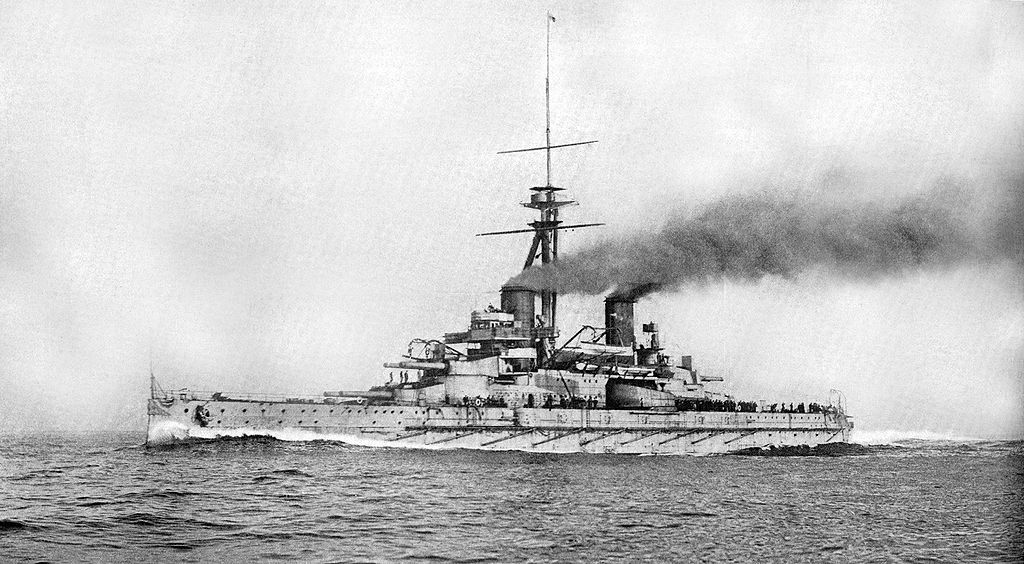
As the result, Brazil was the third country to order a ship powerful enough to beat everything that floated at that time. On paper they were quite superior to both the Dreadnought and South Carolina, the very peak of power and prestige a Nation can own at the time. This caused a stir worldwide, not only in South America, triggering a new naval arms race quite unique in history. The race ended in 1914, among requisitions in British yards, detrimental to Brazil and Chile. All these battleships would be somewhat modernized and served through WW2 and in the early cold war as well, the pride of their nations.
But as the British Navy League Annual put it at the time, news of their construction “astonished the naval world”. They sparked a maelstrom of controversy, gave birth to the wildest conspirational theories and fake news in the mainstream press. In short it had an impact we have difficulties today to grasp. Dreadnoughts at the time were the costiest man-made moving objects in history. That a “second rate” country could order ships that were way ahead of anything that float at that time fuelled indeed a lot of interrogations.
About the dreadnought race
The three south american powerhouses, Argentina, Brazil and Chile were for long in open rivalry, an inheritance from wars of the XIXth century. The Cisplatine War between Brazil and Argentina in 1827, for example was a post-Bolivarian attempt to define frontiers around valuable resources, and saw many naval battles like at Punta Colares, Juncal and Monte Santiago.
In 1851, the Platine war, in 1864 the Uruguayan and Paraguayan Wars, and the Acre War in 1898 followed. Relations were warmer with Chile but a fifteen-year naval arms race took place between the latter and Argentina to gain control of the Southern Cone. It started in the 1870s, grew steadily on the late 1880s and ended in 1903 by a British-led naval agreement, leaving the Brazilian Navy “in the dust”.
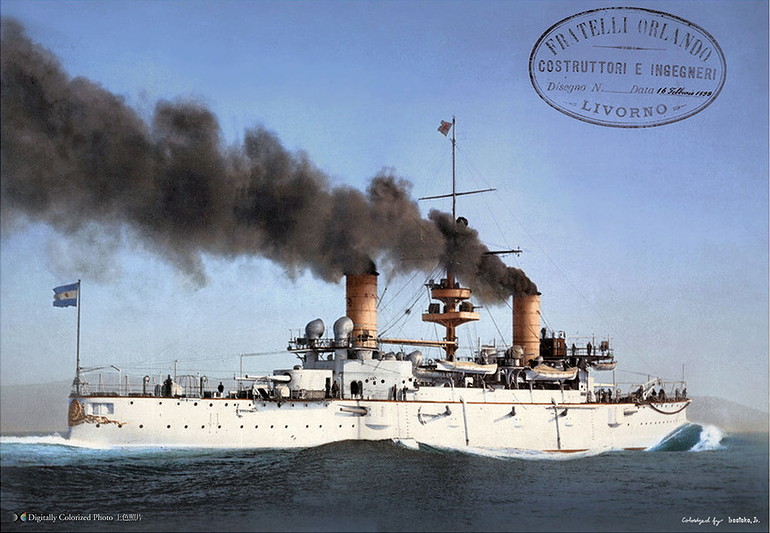
ARA San Martin (1896)
Indeed Brazil did not started any new construction since 1889 and the fall of the Monarchy, and they were further delayed by the civil war, whereas in 1898-1902 the Argentines ensured a clear-cut “victory” in this race by purchasing no less than four brand new Garibaldi-class armoured cruisers, at the time among the very best of the type ever built, at an enormous expense. Not to be undone, the new government, fuelled by recent revenues from coffee and rubber trade had the financial means and popular support to raise a considerable budget, with a population respectively three and five time their rivals.
Therefore at first a vote was obtained in 1904 to order in UK three small pre-dreadnought battleships, with a tailored design which was still ongoing in late 1905. Apparently meanwhile the commission sent in UK was informed that a revolutionary ship was just been ordered and later confirmed at HM Dockyard, Portsmouth, as a gigantic hull was in construction since 2 October.
They immediately telegraphed back to Brazil that ordering three of the new ships instead was a bolder course of action. Later the budget study of the purchase and UK shipyard capacities led the commission to later cancel the third (which was to be the superlative Rio de Janeiro).
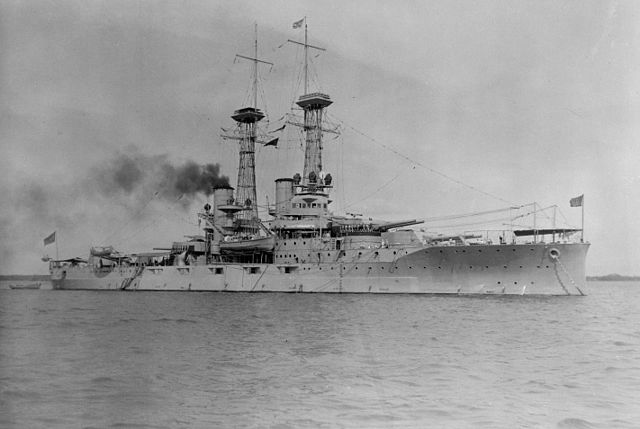
This race was also between shipyards around the world. The Argentine bid created a fierce competition, leading the government to favor local shipyards by sending also the USS Delaware to Brazil and Chile in early 1911 as a “free to test” sample. Eventually, if US shipyards were chosen by Argentina, British ones were chosen by Chile due to long privileged relations with the RN, which proved not to be the best as the war broke out. As a result in a sense Chile “lost” the race, having her battleship back only in 1920. But she was the best of all.
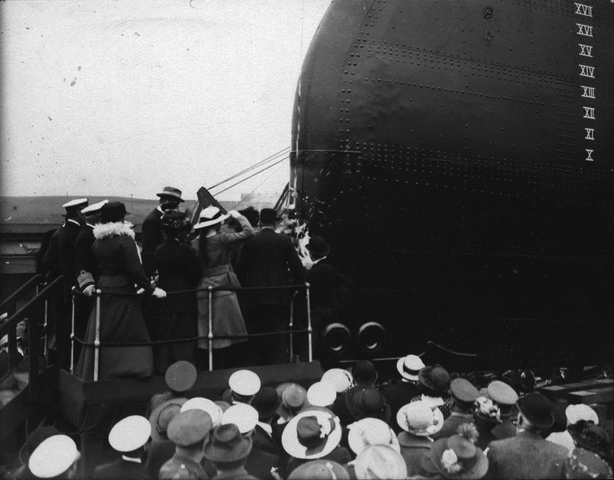
Christening and Launch ceremony of HMS Rio de Janeiro, 10 September 1908
This made already world’s headlines as the order became public and caused a sensation. It was so outrageous that Brazil, not a traditional blue water navy in European terms, could be the third country to possess such ships, before France, Italy, Russia or Germany ! The press went wild as allegation of a proxy purchase for Japan or even for Germany (the ships would have been also reverted and perhaps reverse-engineered) and it calmed down when the construction of the Nassau was known in 1907 and Kawachi (1909) in Japan.
The decision also caused a stir – rightfully so, in South America and was even a source of concern for the US Navy, which first dreadnoughts, the 1907 South Carolina class, were 16,000 long tons and 18.5 knots, armed by eight 12-in versus Brazil’s new battlewagons which were 19,000 tons, 21 knots and armed with twelve 12-in guns ! The Minister of Foreign Affairs, Manuel Augusto Montes de Oca, remarked a bit hyperbolically that these new battleships could wipe out both the Argentine and Chilean fleets with ease.
They also attracted much interest from the British admiralty itself as the ships and battery was larger than the follow-ups of the Dreadnought, Bellorophon and St Vincent classes. The design was approached on the HMS Colossus but with the same ten guns battery, and somewhat overcome with the Orion which swapped on a larger caliber. The Rio would stick and even beat all records on this exercise in more guns versus larger calibers.
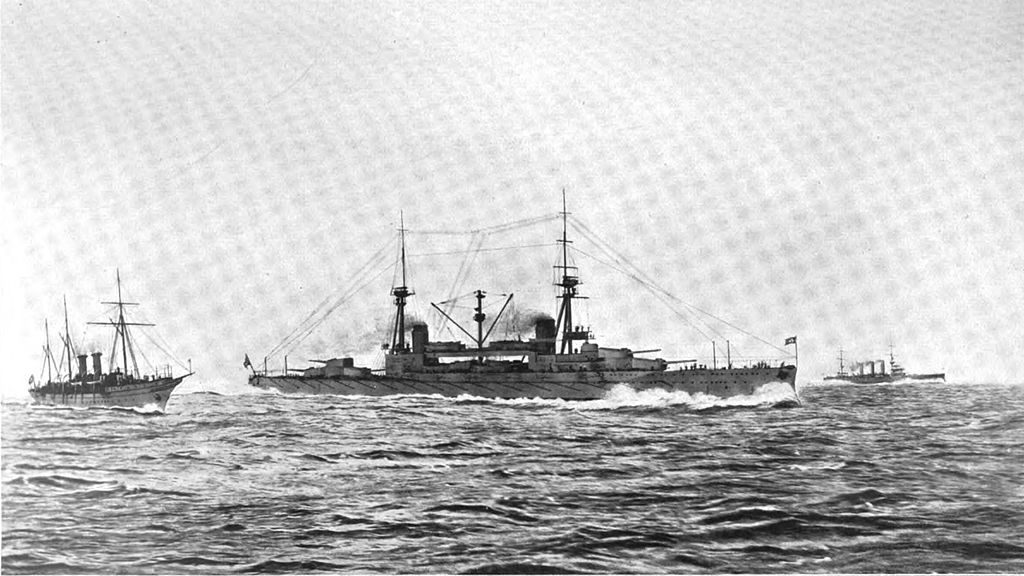
The Rio de Janeiro was the former Sultan Osman I – as depicted her in Brassey’s naval annual 1914′ artist impression. Requisitioned she ended as HMS Agincourt, a very impressive 14x 12-in guns armed capital ship, all in the axis.
Whatever the case, it triggered a reaction of Argentina at first, which not to be outdone, ordered to the USA a pair of their own dreadnoughts in 1910, seeking bids since two years. This was fuelled by further tensions over the River Plate area and by inflammatory newspaper editorials. The massive naval building plan ended after a drawn-out bidding process among fifteen shipyards from every country with a knowhow with large battleships, a fierce competition the Americans won in a background of sudden sympathy tainted of Pan-Americanism and Hemispheric Cooperation. It was accompanied by a massive order of destroyers.
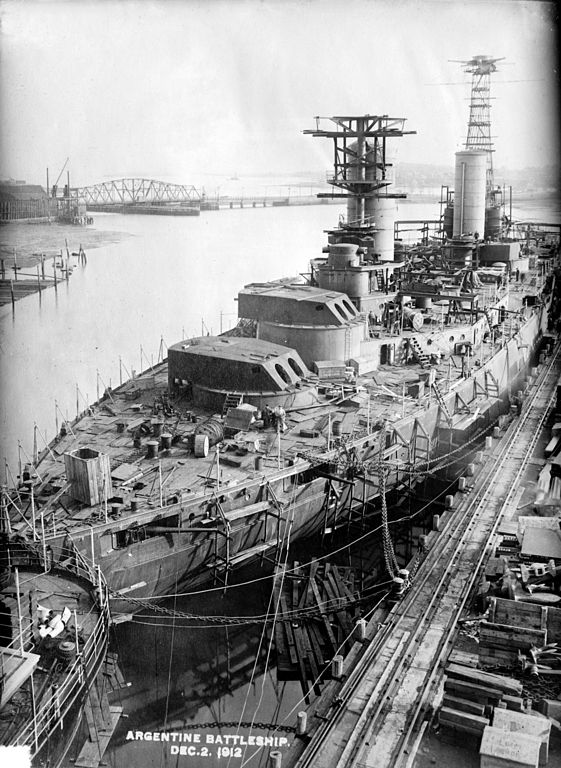
In displacement and gunnery the Rivadavia and Moreno were superior to the Minas Geraes and spawn a response in March 1910 by unlocking the third and fourth orders, Rio and Riachuelo. The first dragged on as the design was altered in May and completely redrawn, and therefore was requisitioned in 1914 while the second only was only planned when the war broke out. She was in service throughout WW1 as HMS Agincourt but proved not to be a good design overall.
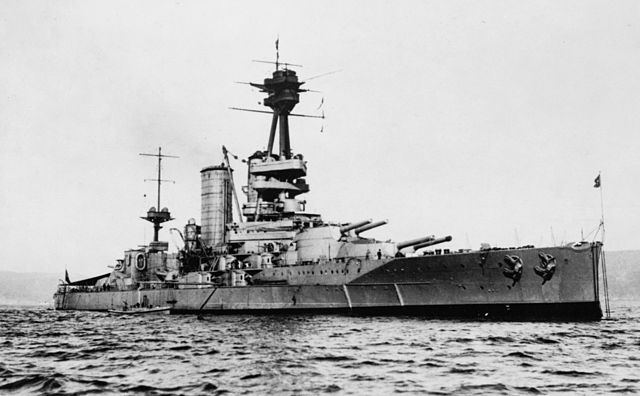
Almirante Latorre in the interwar. The British government at first resisted a transfer back to Chile as it would destabilize the region and relaunch a possible arms race. Later the Almirante Cochrane was also asked for, but the Royal Navy which was reconstructing her argued that the cost of rebuilding her was just too much for Chile, and the prospect was dropped. In effect this toned down the consequences of Latorre being commissioned in Chile. Armed with ten 14-in guns and capable of 22.75 knots she was indeed superior to the Brazilian and Argentinian capital ships.
The third player in this race was of course Chile, which financial wealth was not on the same level, yet her congress consented to order two battleships of the Almirante Latorre class in late 1911 after an earthcake and economical recession. Construction was delayed but in 1914 while the first ship was nearly completed, requisitioned by the Royal Navy as the war broke out, to be used as HMS Canada, retro-ceded after the war. The second one, Almirante Cochrane, was taken in hands to be converted as an aircraft carrier (HMS Eagle).
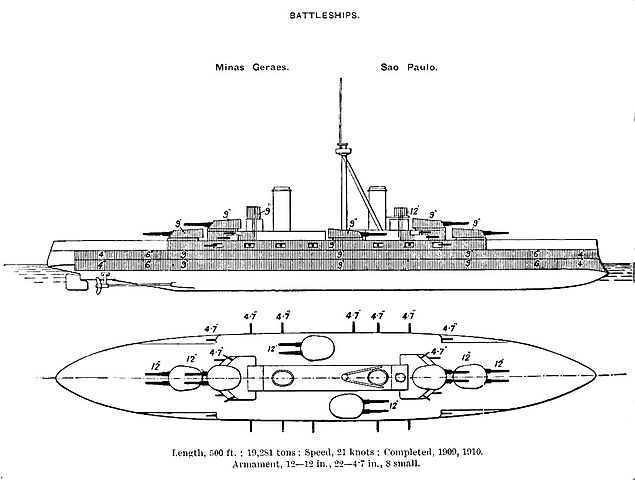
Minas Gerais – Brasseys annual
Development of the Minas Geraes
A controversial design and adoption
Two factions emerged as what type of ship was to be ordered: Either a small number of large warships, or a larger fleet of smaller ones. The latter prevailed with an order for three small battleships initially, to be completed by three armored cruisers, six destroyers, twelve torpedo boats, three submarines, and two river monitors.
As it happen later for budgetary reasons, the armored cruisers were scrapped, and minister Admiral Júlio César de Noronha signed with Armstrong Whitworth for the three pre-dreadnoughts on 23 July 1906. They were based on the coastal BS Norge and 2nd class Swiftsure, a mixture the yard called Design 439. Basics were 11,800 long tons, 19 knots, 9-in for the belt and 1.5 in for the decks, twelve 10-in guns in six twin turrets in a hexagonal configuration. They were some sorts of Cuniberti-style monocaliber armoured cruisers
Informed possibly through the naval attaché in Brazil, the American ambassador cabled his Department of State, arguing the destabilization and full naval arms race it will cause. Theodore Roosevelt tried then to coerce the Brazilian government but his attempts failed, the main advocate of firmness being the Baron of Rio Branco. President Afonso Pena ratified the acquisitions which was confirmed at the National Congress of Brazil in November 1906.
The revised design
Meanwhile the yard received demands to modify the Design 439 well before the ships were laid down. The displacement rose to 14,334 long tons (14,564 t), the hull being longer and wider. The first was laid down by Armstrong, Elswick (Newcastle upon Tyne) and the other expected to be subcontracted to Vickers/Barrow. As we saw above, the new dreadnought concept showcased by the yard in December 1906 completely changed the game.
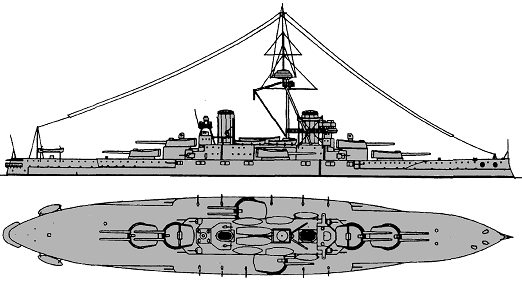
Conway’s side and top view as of 1911
This triggered a return of the first faction, ie in favor of a few, very powerful capital ships, led by Rear Admiral Alexandrino Faria de Alencar, with a complement in budget for two dreadnoughts and provisions for a third dreadnought. The plan was completed by two scout cruisers (Bahia class), ten destroyers and three submarines. As a result, The hulls of the three “Nassau-style” battleships were broken up from 7 January 1907.
The “sport” started when the redesign was made. The new ships inscoporated the latest dreadnought technology under the pen of J.R. Perrett (Elswick Ordnance Company. It was approved by the Brazilian government on 20 February 1907, and was made public, causing Argentina and Chile to scrap their 1902 treaty over their previous naval arms race.
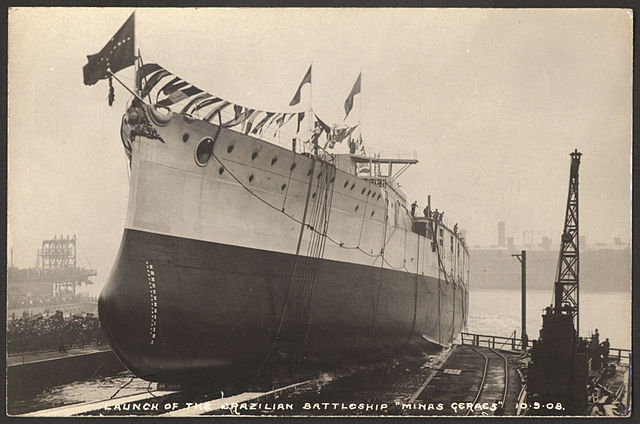
Minas Gerais launch in 1908
When the design was completed and the new keels were laid down, the dreadnought design was still in its infancy, with concerns of the ship’s brand new superfiring turret arrangement -over the blast which could hurt the crew or even damage the lower turret. They were dissipated after the firing tests but the concerns were still raised by the press by June 1910.
Final Design of the Minas Geraes
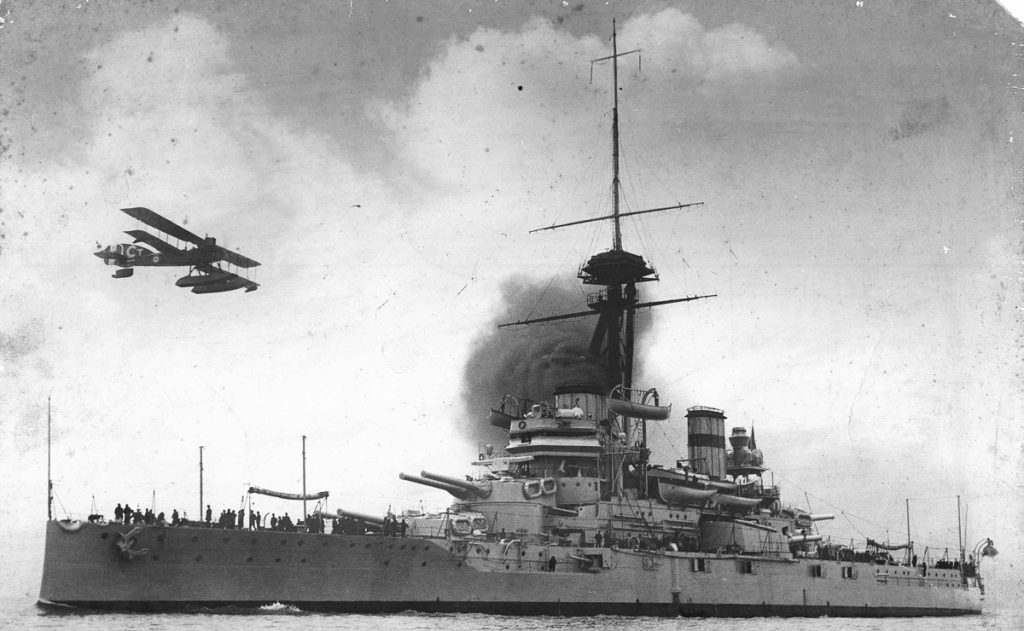
São Paulo in WW1 – wikimedia commons via Flickr
In a few lines, the Minas Geraes (Or ‘Gerais’) were not only the largest and mightest battleships in the world on paper at that time, they innovated in some ways, by using for the very first time on a battleships superfiring turrets. This was a brand new arrangement that sparked a lot of interest and fears. The rest of the artillery was placed in echelon, like on the Colossus and Neptune. The latter also had superfiring rear turrets, but only after the confirmation of the Minas Geraes fire trials. The ship indeed gave the opportunity to the Royal Navy to test these ideas without taxpayer money.
The Brazilian dreadnoughts displacement was established at 18,976 long tons (19,281 tonnes (t)) normal, 20,900 long tons (21,200 t) at full load, about the same as the St Vincent, with the benefit of one more turret. The hull was longer at 543 ft (165.5 m) overall versus 536 ft (163.4 m) but slightly narrower at 83 ft (25.3 m) versus 84 ft 2 in (25.7 m) on the St. Vincent.
Propulsion
The minas Gerais and São Paulo were propelled by two shaft mated on Vickers vertical triple expansion engines, fed by 18 Babcock & Wilcox boilers, rated for a total of 23,500 shp (17,500 kW). This was not as advanced than the turbines rated for 24,500 shp (18,300 kW) on the St Vincent four shafts, which provided a top speed of 21 knots (39 km/h; 24 mph), the same on Minas Gerais. It proved that a dreadnought could stick to traditional VTE engines and still do quite well. However in practice overtime it often fell short of this, because substandard maintenance and neglect. Range was 10,000 nmi (12,000 mi; 19,000 km) at 10 knots (12 mph; 19 km/h) larger than the St Vincent’s 6,900 nmi.
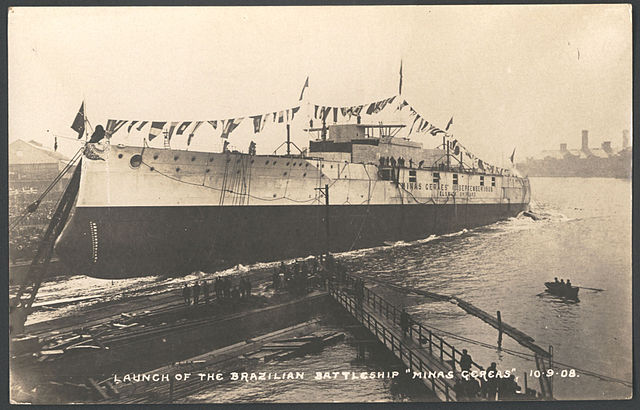
Protection
The main armor belt was made with Krupp cemented armor, nine inches (230 mm) thick. It was rduced to six and three inches (150 and 76 mm) on both ends. Barbettes had nine-inch armor, while the main turret were protected by a 12-in (300 mm) front plate and 8-in (200 mm) side plates, and 2-3-in (51 to 76 mm) on top. The conning tower was only protected by 12-in (305 mm). Multiple deck armor levels ranged from 1, 1/2 to 2 in (38 to 51 mm). These figures were all better than the St Vincent class, which had substandard armor thickness.
Armament
Certainly the strongest point, these battleships wre the best armed of their time. The design main innovation, superfiring turrets, was the only way to preserve realistic hull lenght. There were still many interrogations though, related to the superfiring concept itself (as shown by the USS Kearsage before, which radically “empiled” turrets). In short it was by then only studied by another Nations, the USA, for their initial dreadnought, the South Carolina; But the minas Gerais “washed the plaster” on this anyway. The configuration seemingly weakened the hull integrity where the large barbettes has been pierced through, but allowed a chase and retreat fire of eight guns.
The guns themselves were the standard 12-inch/45 caliber produced by Eslwick, 1906 pattern. Dozens were made for many Dreadnought classes, and exported. The Bore was 45 feet (13.716 m) (45 cal), they fired a shell of 850 pounds (385.6 kg), for a caliber of 12-inch (304.8 mm). Muzzle velocity was between 2,700 feet per second (823 m/s) and 2,800 feet per second (853 m/s) depending on the round (HE or AP), with a maximum firing range of 18,850 yards (17,240 m).
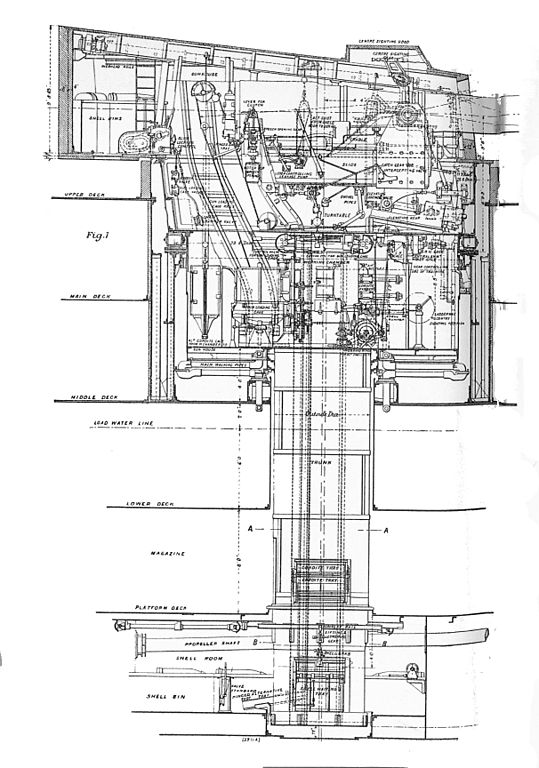
The secondary armament was a bit unusual, a battery of twenty-two 4.7 (120 mm)/50 cal. guns. It was still better than the weaker 4-inch (102 mm) guns of the St Vincent introduced with the previous Bellorophon as the Dreadnought was seen as too radical. This caliber was kept until the Iron Duke class, which introduced the famous 6-in (125 mm) caliber. These 4.7 in guns were placed in barbettes along the main deck, and in superfiring positions in the casemate, foward and aft.
The tertiary battery comprised eighteen 3-pounder (47 mm) guns and eight 1 pdr (37 mm) guns to deal with torpedo boats; They were placed by pairs on the roof of main turrets B, X, and the echelon turrets, along the funnels, and bridges. There were no torpedo tubes.
The crew was around 900 men. The total cost of the two ships was considerable already for a great power, more so for Brazil, at an estimated $8,863,842. £6,110,100, without ammunition (£605,520) and upgrades to docks (£832,000). And this already staggering amount was nothing compared to maintenance costs, about 60% of the initial cost for just the first five years of service. This certainly explain the lack of maintenance both ships suffered and which condemned in particular São Paulo to a service punctuated by long inactivity. Despite it all, the two battleships stayed in service until 1953, so for 43 years.
Specifications of Minas Gerais (WW1) |
|
| Dimensions | 165.5 x 25.30 x 7.6m (543 x 83 x 28 ft) |
| Displacement | 18,976 t, 20,900 t FL |
| Crew | 900 |
| Propulsion | 2 shafts VTE, 18 B&W Boilers, 23,500 hp |
| Speed | 21 knots (24 km/h; 39 mph) |
| Range | 10,000 nmi (12,000 mi; 19,000 km) at 10 knots (12 mph; 19 km/h) |
| Armament | 12x305mm/25 (6×2), 6x120mm/50, 18x47mm, 8x37mm. |
| Armor | Belt: 102-229 mm, Decks: 40 mm, Turrets 76-305 mm, CT 300 mm |
The Minas Geraes in service
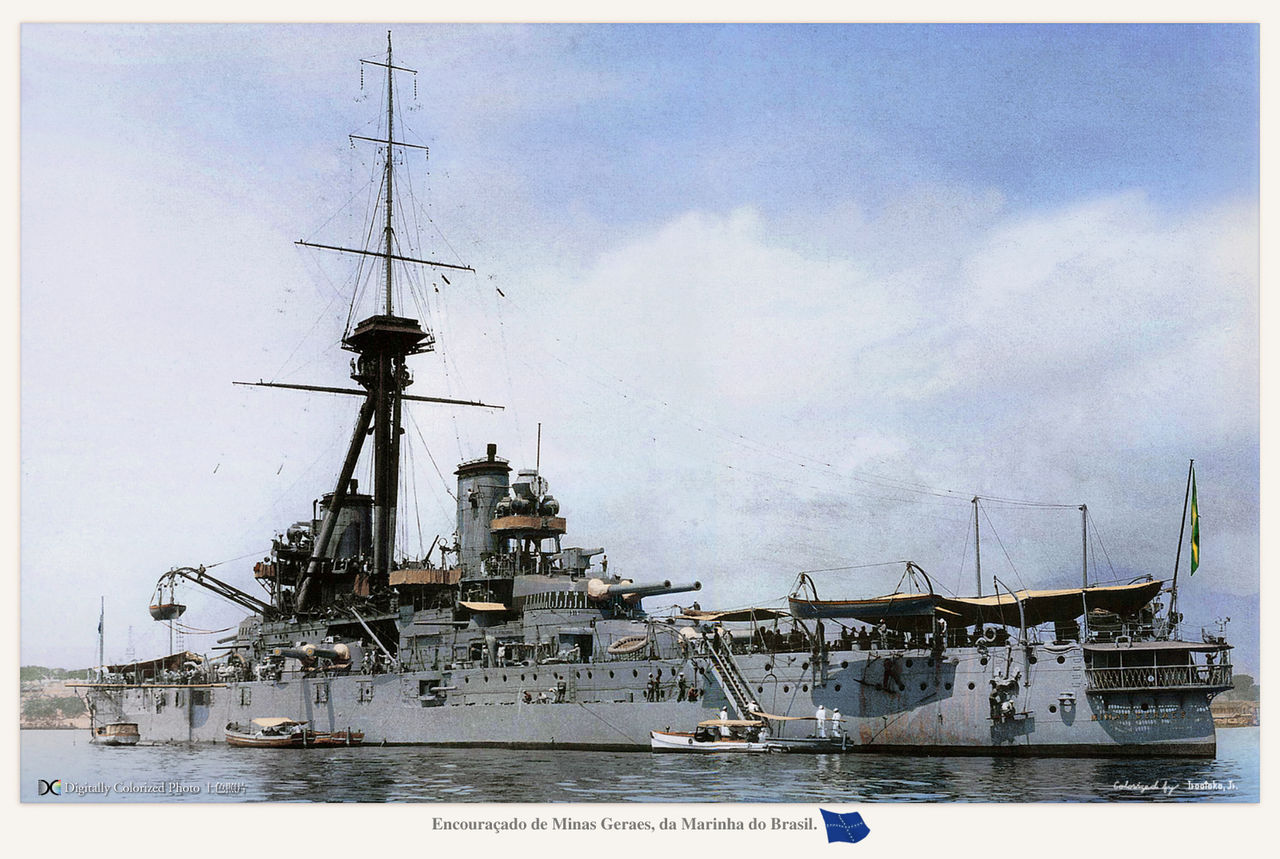
Before even to reach Brazil, both battleships, after making such sensation in the press and to prove the order was genuine, showed the flag in many countries: The first, leaving the Tyne on 5 February 1910, stopped at Plymouth and sailed to the USA on 8 February, escorting the North Carolina with the body of the former Brazilian ambassador Joaquim Nabuco to Rio. São Paulo left Greenock on 16 September 1910, stopped in Cherbourg (France) to carry back President Hermes da Fonseca. Departing on 27th, she stopped at Lisbon where Fonseca was a guest of Portugal’s King Manuel II just before the October 1910 revolution at home.
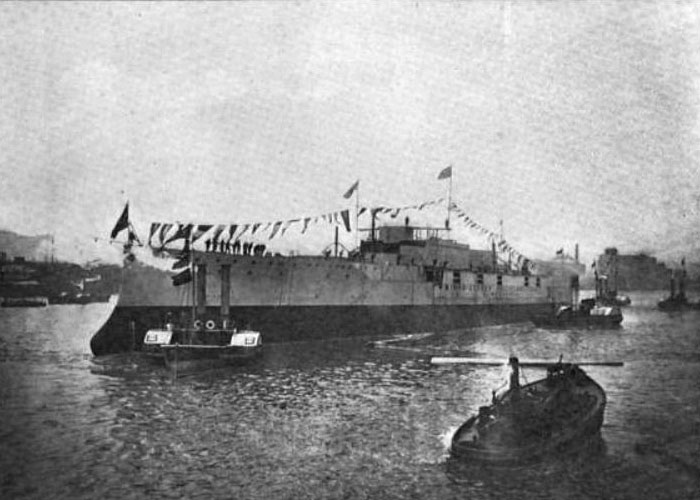
Minas Geraes after launch. She only displaced about 9100 tons at that stage.
Revolt of the Lash (1910)
São Paulo left Lisbon on 7 October for Rio de Janeiro, docking on 25 October. However soon after arrival, a major rebellion “of the Lash”, Revolta da Chibata started on four Brazilian ships, caused when Afro-Brazilian sailor Marcelino Rodrigues Menezes was flogged 250 times for insubordination. The rebellion started really on 22 November and the Minas Geraes, São Paulo, Deodoro, and Bahia were seized by the crews with only five officers killed.
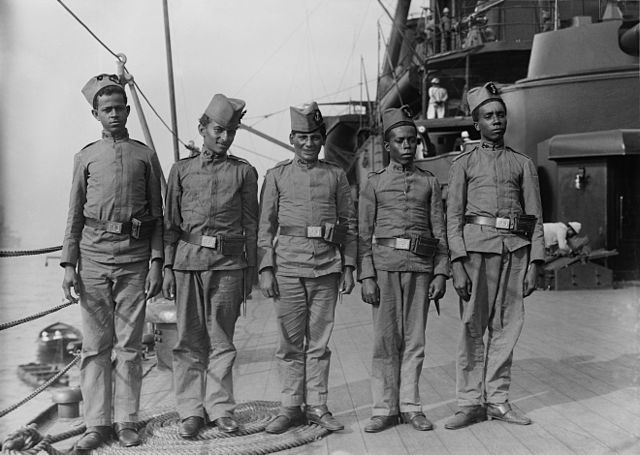
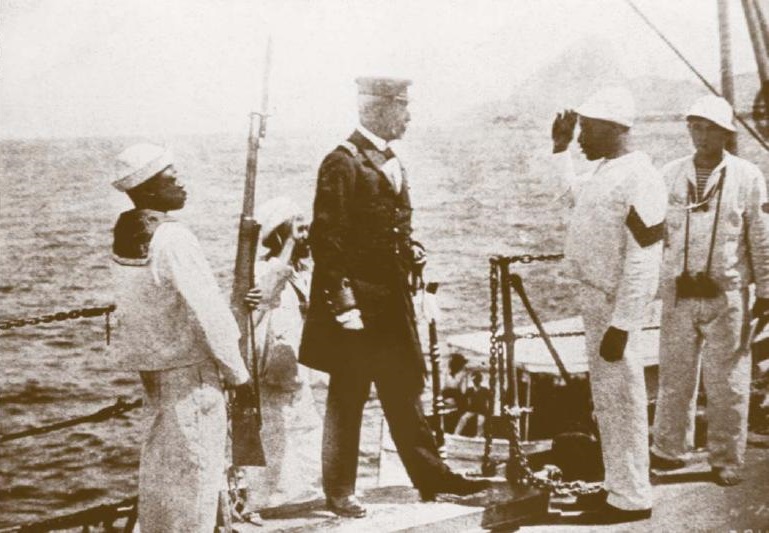
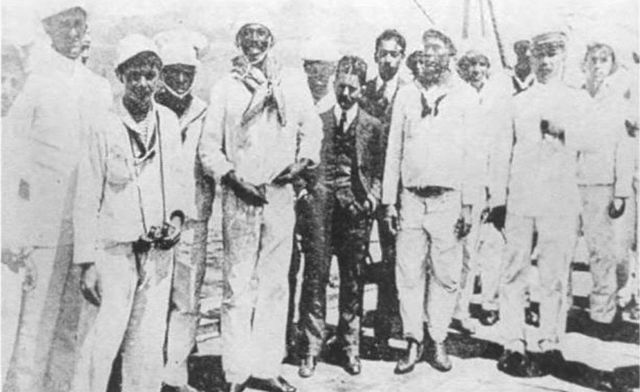
Crew and scenes on board Minas Geraes during and after the Revolt. Last one: João Cândido Felisberto and crew visited by journalists the last day of the revolt;
Their demand was soon known, the abolition of “slavery as practiced by the Brazilian Navy”. They denounced the low pay, long hours, inadequate training and harsh punishments with the lash and Bôlo. Their demands were granted by the National Congress, causing a stir among officers. Supported by the president of Brazil they denied any amnesty for the mutineers.
However their plot to assault the ships failed after the bill was passed. During all this time the mutineers seems to have perfectly maintained the ship well supplied, in order and discipline, ready for any action.

Introduction booklet by Charles de Lacy distributed for the launch.
Minas Gerais and São Paulo in WW1
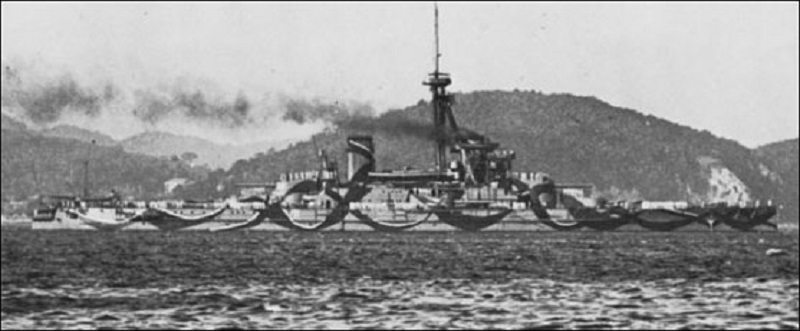
Camouflaged São Paulo in 1918
Prior to the war in 1913, Minas Geraes transported Brazilian Minister of Foreign Affairs Lauro Müller to the United States and later joined São Paulo for large scale exercises. Reports of the need for modern fire control system was not followed by any action. Brazil entered the great war in 1917, even offering both battleships for the Grand Fleet, but after inspection it was denied. The ships did not had any modernization and lacked maintenance.
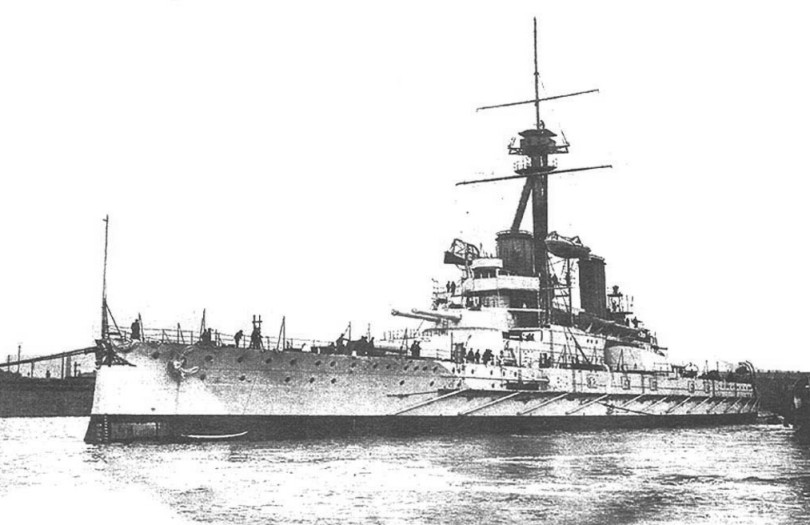
They could not equate the standards of the Royal Navy. The situation was grave enough that when São Paulo was sent for a modernization to the USA, only four boilers on 18 total worked correctly, propelling the ship at an appealing pace; On her first leg even the latter failed, and the ship had to be towed by USS Nebraska and Raleigh to the yard in New York. It was done in 1918-19 and followed by Minas Geraes in 1920-21, mainly the replacement of steam engines, fitting of new clocks and other details. The grand modernization had to wait for longer;
Interwar service
Their 1920s service was marked by honorary tasks such as conveying King Albert I and Queen Elisabeth of Belgium to Brazil for the São Paulo or take back home the bodies of exiled Emperor Pedro II and his wife. Both ships also qualled the Tenente revolts (Revolução Tenentista), shelling to surrender a rebel fort. In 1924 there was another mutiny of three lieutenants on São Paulo. They failed and later escaped by capturing a torpedo boat, sailing to Montevideo where they were interned. The ship was later returned hom, escorted by the battleships. While Minas Geraes was modernized, São Paulo led a naval force lifting the naval blockade of Santos during the Constitutionalist Revolution of 1932.

View of the boats from the upper turret
American modernization of Minas Geraes (1921)
She received Sperry fire-control systems, Bausch and Lomb range-finders for the two superfiring turrets. These turrets were secured by the adoption of a vertical armor bulkhead. The secondary battery was cut from 22 to 12 guns. The five superfiring ones in casemates were removed. Also, modern AA guns consiosting of two 3″/50 (Bethlehem Steel) ordnance pieces were added on the aft superstructure. New 1.5 in guns were also added near the turrets while the vintage 3-pdr were all removed.
Interwar reconstruction of Minas Geraes

She was conducted at Rio de Janeiro Naval Yard, operations starting on June 1931 and completed in 1938. São Paulo’s own poor condition (she was capable only of 10 knots) cancel any attempt of a modernization. First step was to adopt all-oil firing for boilers. These were six brand new Thornycroft models. The first boiler room and its twelve side coal bunkers were converted to fuel oil storage tanks while the upper coal bunkers were deleted. This rearranged the funnels into a single truncated unit.
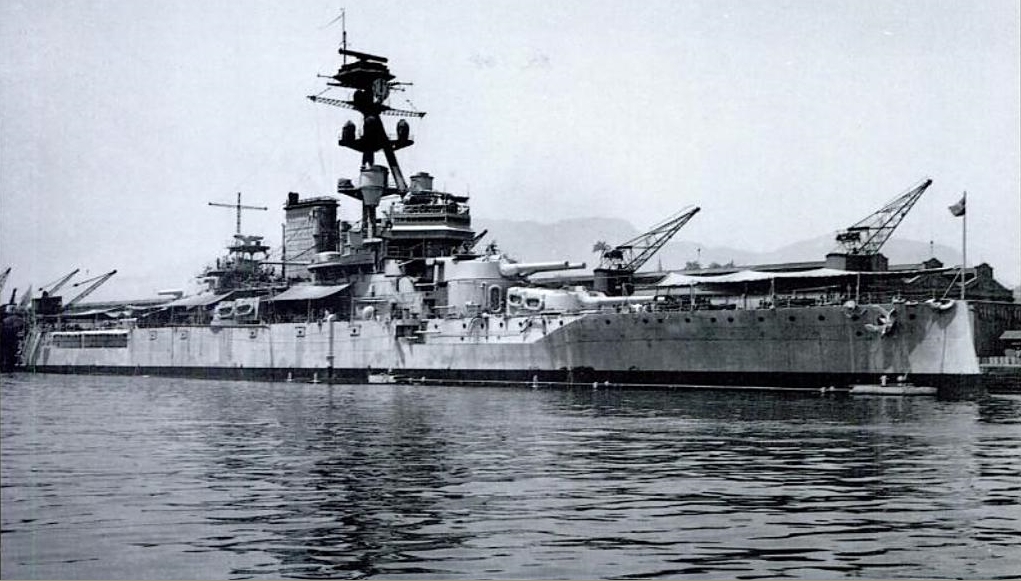
Dynamos were replaced by turbogenerators. The fire-control systems were alsp brand new Zeiss range-finders. The guns and their cradles were changed, with a maximum elevation going from 13° originally to 18°. Also the secondary armament received two extra 4.7 in (120 mm) guns plus six 20 mm (0.79 in) AA Madsen guns. They replaced the vintage 2-pounders.
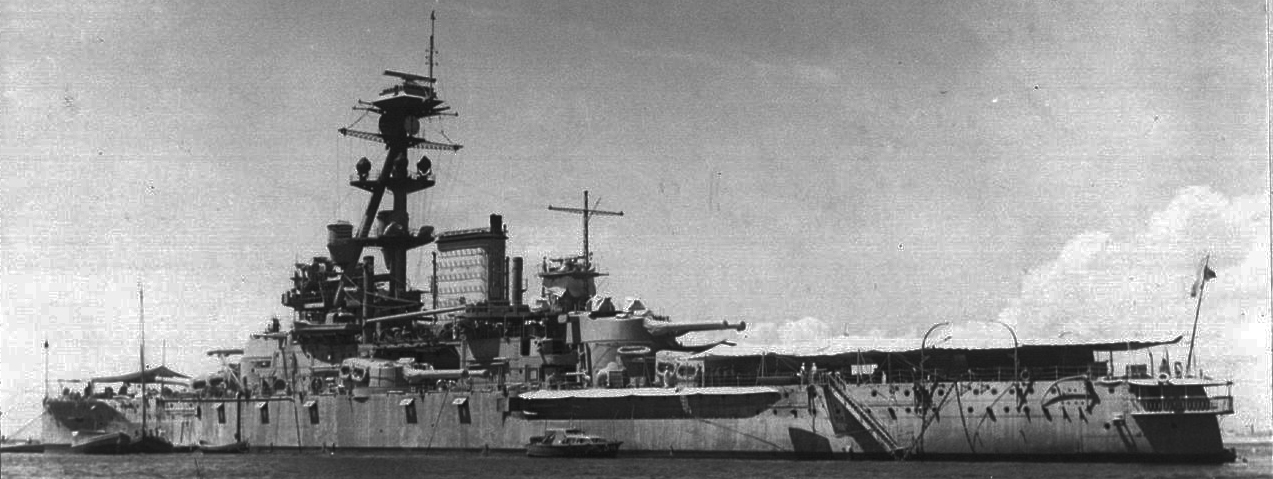

Stern and top views of the Minas Geraes, after reconstruction.
Minas Geraes in WW2
As German attacks on Brazilian trade eventually pushed Brazil to declared war on 21 August 1942, the old fleet was composed of Minas Geraes, São Paulo, Bahia and Rio Grande do Sul. Despite her modernization, Minas Geraes was in poor state and instead of patrolling the Atlantic, she was anchored as a floating battery in Salvador until 1945.
She remained inactive and was eventually decommissioned on 16 May 1952. She was used as stationary headquarters for the Brazilian Navy C-in-C until 17 December. She wa stricken on 31 December, sold to an Italian shipbreaker, SA Cantiere Navale de Santa Maria. Towed there up to 22 April, she was later broken up for scrap.
São Paulo’s late service
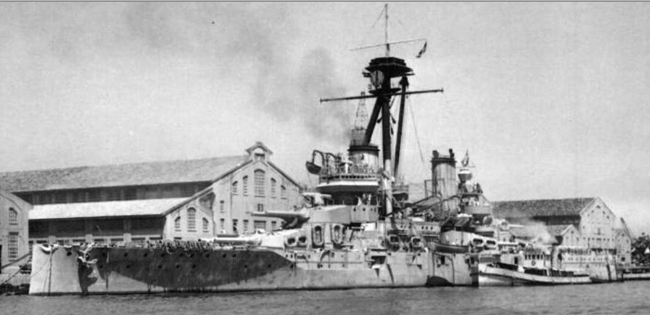
São Paulo in 1942
The early part of the São Paulo’s career mirrored the Minas Geraes. During WW1, precisely in 1918, her machinery cased to function propery, here boilers were inoperative for the most and she barely can move, while departing to New York for a modernization. American battleship Nebraska provided immediate assistance, enough to allow her to join Bahia for temporary repairs. Afterwards, escorted by Nebraska and helped by Raleigh later, she made it to New York and emerged in 1920. The range of modifications were the same as Minas Gerais. Afterwards she sailed Cuba for firing trials which took place in Gulf of Guacanayabo. She later anchored at Guantanamo and left for Brazil.
She carried back to Belgium the Royal Family in August 1920, taking back the bodies of the last Brazilian Emperor and his wife. In 1922 she helped surpressing the Tenente revolts. However her crew mutined on 4 November 1924. She tried to rally other ships to their cause and departed frop Rio de Janeiro. She was damaged by the nearby forts of Santa Cruz and Copacabana, damaging her funnel and fire control system, but she replied. São Paulo eventually was interned in Montevideo, Uruguay and bring back home escorted by Minas Geraes.
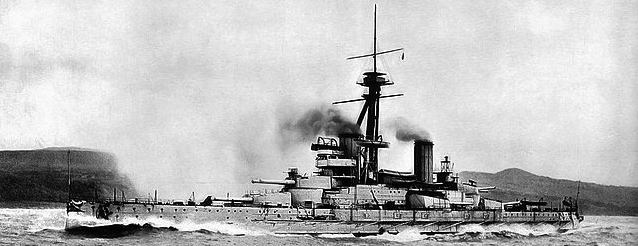
São_Paulo on trials, 1910
In 1930 her poor general state prevented any attempt of modernization and she was anchored as a coast-defense ship. Despite of this she blockaded rebels during the Constitutionalist Revolution, at Santos. She went to the drydock in 1934-35 and participated in naval training exercises. She also carried the Brazilian President Getúlio Vargas up the River Plate to Buenos Aires for a meetng with Argentina and Uruguay. After war was declared on 21 August 1942, the battleship sailed to Recife and was stationed here for the remainder of the war to act as a defense ship.
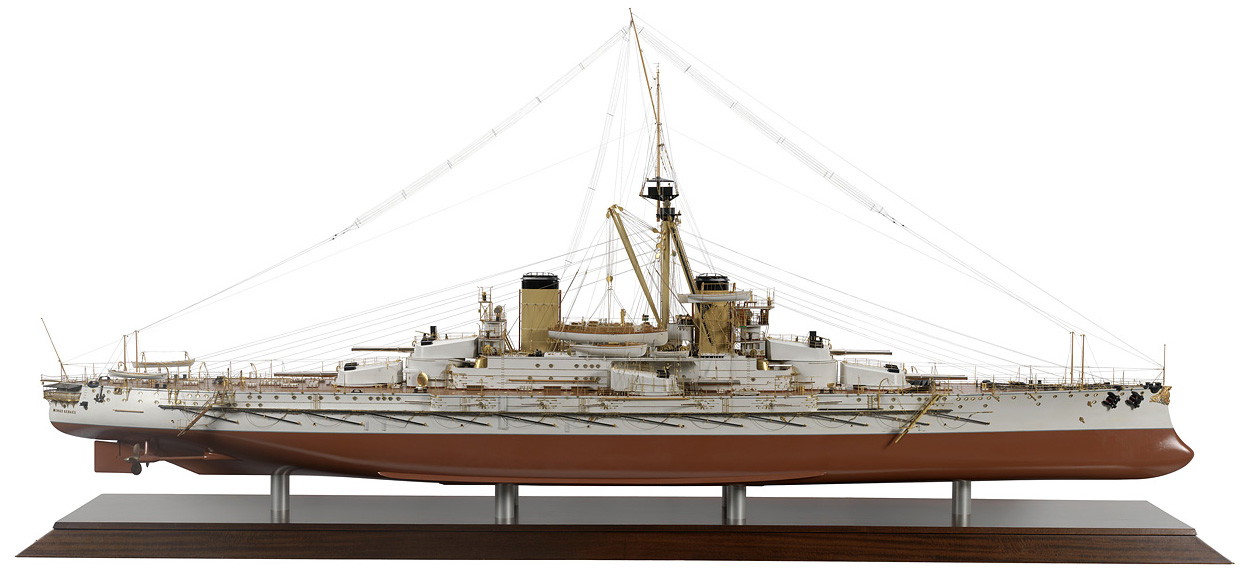
Shipyard model of the Minas Geraes – Greenwhich museum collections
She returned to Rio de Janeiro in 1945, was stricken 2 August 1947 but went on to serve as a static training vessel until 1951. She was later sold to Iron and Steel Corporation and BU in Great Britain. Howver she sank en route, north of the azores, after her tugs severed their wires to avoid sinking or collided with her. The enquiry concluded a probable position in 1954 when she capsized with her crew, her wreck has never been found.
Her bell has been preserved in Ibirapuera Park, São Paulo.
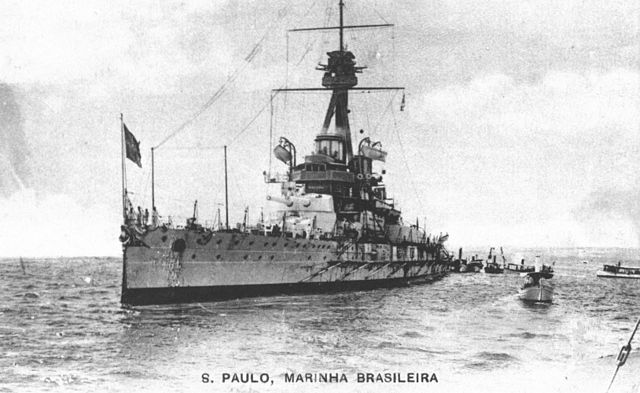
Read More/Src
Campbel, Gardiner, Gray, Randal, ed. Conway’s All the World’s Fighting Ships: 1906–1921.
Annapolis: Naval Institute Press
Adrian J. (1984). Armed Forces of Latin America. Jane’s Publishing Inc.
Livermore, Seward W. (1944). «Battleship Diplomacy in South America: 1905–1925».
The Journal of Modern History. 16 (1): 31–44.
Mead, Edwin D. (1908). «Reaction in South America». Advocate of Peace (10)
Scheina, Robert L. (1987). Latin America: A Naval History 1810–1987. Annapolis Naval Institute Press
Topliss, M.J. (1988). «The Brazilian Dreadnoughts, 1904–1914». Warship International.
https://en.wikipedia.org/wiki/Argentine%E2%80%93Chilean_naval_arms_race
South_American_dreadnought_race
Minas_Geraes-class_battleship



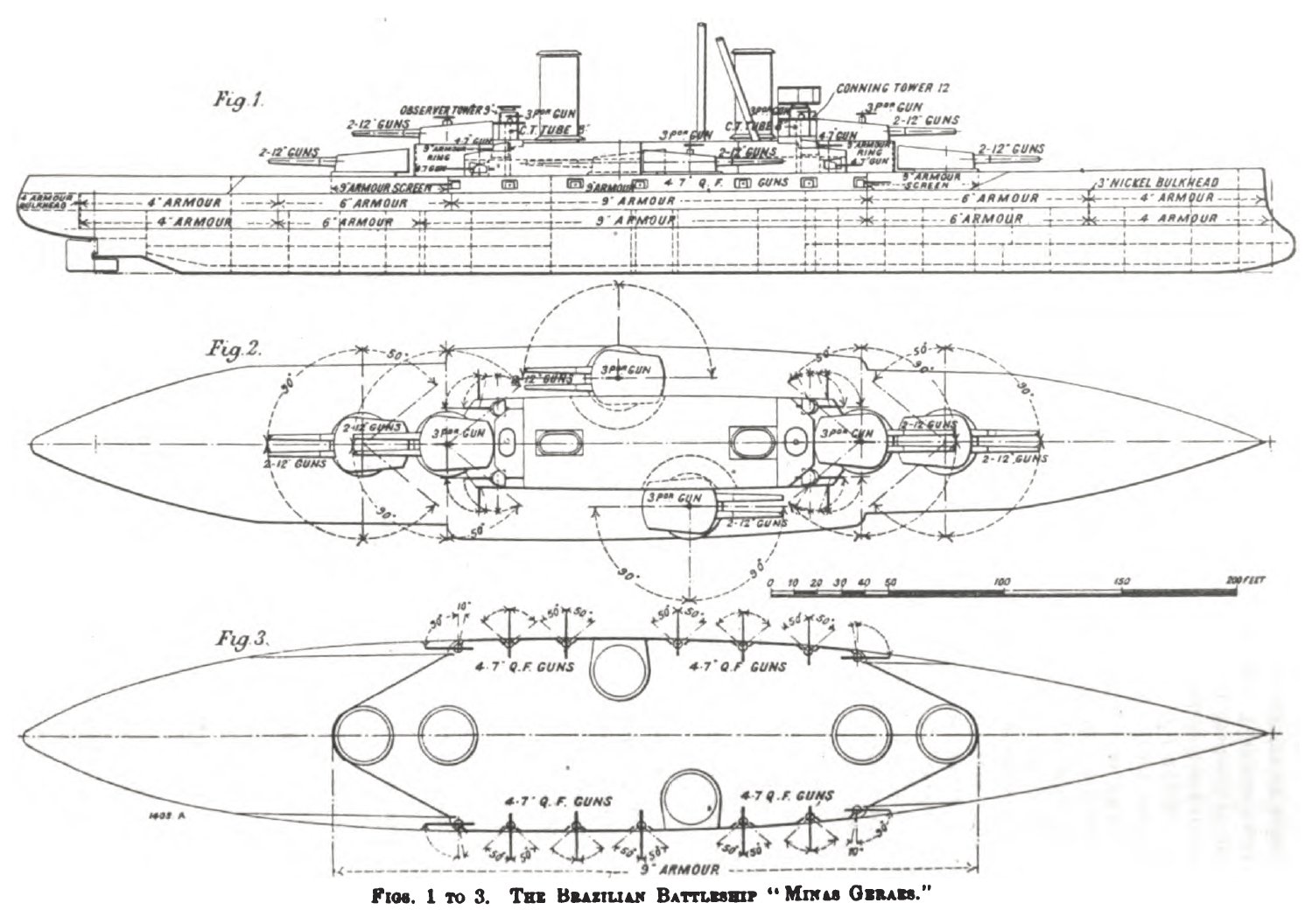
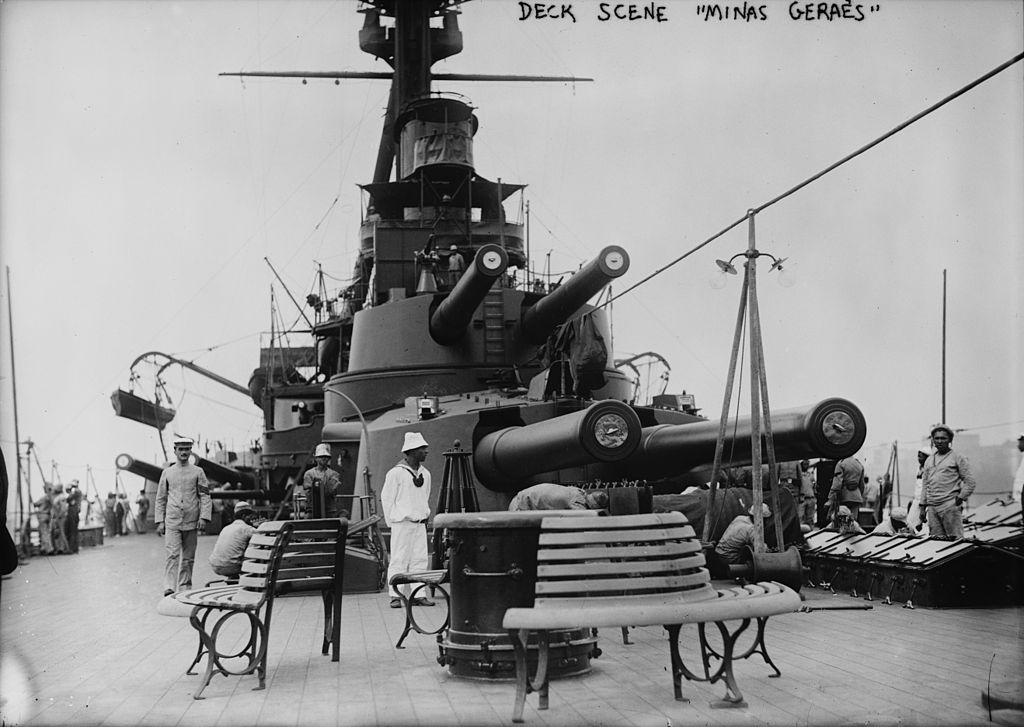
 Latest Facebook Entry -
Latest Facebook Entry -  X(Tweeter) Naval Encyclopedia's deck archive
X(Tweeter) Naval Encyclopedia's deck archive Instagram (@navalencyc)
Instagram (@navalencyc)





 French Navy
French Navy Royal Navy
Royal Navy Russian Navy
Russian Navy Armada Espanola
Armada Espanola Austrian Navy
Austrian Navy K.u.K. Kriegsmarine
K.u.K. Kriegsmarine Dansk Marine
Dansk Marine Nautiko Hellenon
Nautiko Hellenon Koninklije Marine 1870
Koninklije Marine 1870 Marinha do Brasil
Marinha do Brasil Osmanlı Donanması
Osmanlı Donanması Marina Do Peru
Marina Do Peru Marinha do Portugal
Marinha do Portugal Regia Marina 1870
Regia Marina 1870 Nihhon Kaigun 1870
Nihhon Kaigun 1870 Preußische Marine 1870
Preußische Marine 1870 Russkiy Flot 1870
Russkiy Flot 1870 Svenska marinen
Svenska marinen Søværnet
Søværnet Union Navy
Union Navy Confederate Navy
Confederate Navy Armada de Argentina
Armada de Argentina Imperial Chinese Navy
Imperial Chinese Navy Marinha do Portugal
Marinha do Portugal Mexico
Mexico Kaiserliche Marine
Kaiserliche Marine 1898 US Navy
1898 US Navy Sovietskiy Flot
Sovietskiy Flot Royal Canadian Navy
Royal Canadian Navy Royal Australian Navy
Royal Australian Navy RNZN Fleet
RNZN Fleet Chinese Navy 1937
Chinese Navy 1937 Kriegsmarine
Kriegsmarine Chilean Navy
Chilean Navy Danish Navy
Danish Navy Finnish Navy
Finnish Navy Hellenic Navy
Hellenic Navy Polish Navy
Polish Navy Romanian Navy
Romanian Navy Turkish Navy
Turkish Navy Royal Yugoslav Navy
Royal Yugoslav Navy Royal Thai Navy
Royal Thai Navy Minor Navies
Minor Navies Albania
Albania Austria
Austria Belgium
Belgium Columbia
Columbia Costa Rica
Costa Rica Cuba
Cuba Czechoslovakia
Czechoslovakia Dominican Republic
Dominican Republic Haiti
Haiti Hungary
Hungary Honduras
Honduras Estonia
Estonia Iceland
Iceland Eire
Eire Equador
Equador Iran
Iran Iraq
Iraq Latvia
Latvia Liberia
Liberia Lithuania
Lithuania Mandchukuo
Mandchukuo Morocco
Morocco Nicaragua
Nicaragua Persia
Persia San Salvador
San Salvador Sarawak
Sarawak Uruguay
Uruguay Venezuela
Venezuela Zanzibar
Zanzibar Warsaw Pact Navies
Warsaw Pact Navies Bulgaria
Bulgaria Hungary
Hungary

 Bundesmarine
Bundesmarine Dutch Navy
Dutch Navy Hellenic Navy
Hellenic Navy Marina Militare
Marina Militare Yugoslav Navy
Yugoslav Navy Chinese Navy
Chinese Navy Indian Navy
Indian Navy Indonesian Navy
Indonesian Navy JMSDF
JMSDF North Korean Navy
North Korean Navy Pakistani Navy
Pakistani Navy Philippines Navy
Philippines Navy ROKN
ROKN Rep. of Singapore Navy
Rep. of Singapore Navy Taiwanese Navy
Taiwanese Navy IDF Navy
IDF Navy Saudi Navy
Saudi Navy Royal New Zealand Navy
Royal New Zealand Navy Egyptian Navy
Egyptian Navy South African Navy
South African Navy






























 Ukrainian Navy
Ukrainian Navy dbodesign
dbodesign
Did anyone ever discover the wreck of the Sao Paulo, after she sank in 1951?
Or has anyone suggested a search off of the Azores to find the wreck? More
over, would Mr. Ballard, who found the Titanic, Hood and the Bismarck be of
interest in trying to locate the wreck site?
Hello Alvin, still nothing on wrecksite.eu, so…
You mention in her 1938 modernization that six 20 mm/60 Madsen AA guns replaced her “vintage 2-pounders”, but I notice on this page that is the only instance you mention said 2-pounders. From what I’ve found, those “vintage 2-pounders” were the modern 2-pounder Mark VIII in single mounts (whether they were the hand-worked Mark VIII or the power-worked Mark XV/XVI, I do not know). From what I can see, the 2-pounder Mk VIII was anything but vintage: their octuple mountings entering service in 1930 and 1936 for the quadruple mountings (both of which seeing use throughout WWII), and the production of their single mountings did not start until the late 1930s, so it seems a bit odd to call that “vintage”. I’d imagine that they are being mistaken for the outdated single 2-pounder Mark II of WWI, but I see source mentioning neither Minas Geraes nor São Paolo receiving the Mk II. Additionally, I’ve seen many sources claim that the AA was changed to 4 single 4-inch/45 guns (which gun isn’t specified but one quotes it as Vickers Armstrong Mk N) and 4 single 2-pounder Mk VIII, and that it wasn’t until her 1940 refit that she had the 4 single 2-pounders replaced with 20 mm/60 Madsen (weirdly some sources quote it as being 6 twin rather than 6 single).
Also, you mention about Iron Duke being the first to utilize 6-inch guns for secondary battery, but you list the caliber as being “ 6-in (125 mm)”, 125 mm is actually 4.92-inches.
Hi sorry for the delay, let me cross-reference brazilian sources.